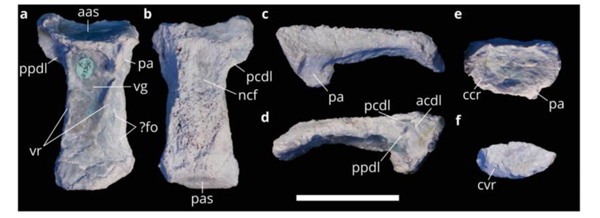Australia’s Latest Theropod Dinosaur
The theropod fossil record for Australia is particularly poor. The majority of the meat-eating dinosaur fossils found down-under come from the Albian-Cenomanian faunal stages of the Cretaceous have been predominantly referred to the Megaraptoridae. However, a single neck bone (cervical vertebra), found in an opal mine near the town of Lightning Ridge (New South Wales), in conjunction with a fragmentary ankle bone from the Gippsland Basin in Victoria have led scientists to conclude that another type of predatory dinosaur roamed Australia – noasaurids.
A Silhouette of the Unnamed Noasaurid with a Human Figure for Scale and the Fossil Neck Bone Placed in Life Position
Picture credit: Tom Brougham (University of New England, New South Wales)
Classifying the Noasauridae
The Noasauridae are a family of small-bodied, fast-running, largely predatory dinosaurs nested within the Superfamly Abelisauroidea, although their exact taxonomic position and which genera fit within the Noasauridae remains controversial. Essentially, these types of dinosaurs are distantly related to the abelisaurids such as Carnotaurus and Rajasaurus.
Noasaurids demonstrate a wide range of anatomical characteristics. For example, Masiakasaurus (M. knopfleri), known from the Late Cretaceous of Madagascar, had a downturned lower jaw with teeth in both jaws, whereas the adult forms of Limusaurus (L. inextricabilis) known from the Jurassic of China, had no teeth in their jaws and could have been herbivores.
A Scale Drawing of Masiakasaurus (M. knopfleri)

Picture credit: Everything Dinosaur
The picture (above) is an illustration of the Masiakasaurus model from the Wild Safari Prehistoric World series.
To view this range: Wild Safari Prehistoric World Figures.
Noasaurids are Known from the Southern Hemisphere
The Noasauridae are known from the Southern Hemisphere and seem to have been confined to the landmass of Gondwana.
Dr Tom Brougham (University New England, New South Wales), one of the co-authors of the study, published in the journal Scientific Reports stated:
“It was assumed that noasaurids must have lived in Australia because their fossils have been found on other southern continents that, like Australia, were once part of the Gondwanan supercontinent. These recent fossil finds demonstrate for the first time that noasaurids once roamed across Australia. Discoveries of theropods are rare in Australia, so every little find we make reveals important details about our unique dinosaur fauna.”
To read more about Limusaurus: Limusaurus – A Dinosaur That Lost its Teeth as it Grew.
The partial cervical vertebra from the Wallangulla Sandstone Member of the Griman Formation, collected from an underground opal mine at the “Sheepyard” opal field, southwest of Lightning Ridge was found within a bonebed containing the iguanodontian Fostoria dhimbangunmal. The bone is estimated to be around 100 million years old.
Present in Australia
Although, the fossil (specimen number LRF 3050.AR), is badly eroded the researchers discovered that is resembled cervical vertebrae associated with the noasaurids, hence the diagnosis that this fossil indicates the presence of these types of theropod dinosaurs in Australia.
The Neck Bone from the Opal Mine Ascribed to the Noasauridae

Picture credit: Brougham et al (Scientific Reports)
The scientists re-examined a ceratosaurian astragalocalcaneum fossil (NMV P221202) that had been found in 2012 in strata associated with the much older upper Barremian–lower Aptian San Remo Member of the upper Strzelecki group in Victoria. It was concluded that this ankle bone also represented noasaurid fossil material.
The East Gippsland Ankle Bone Now Ascribed to the Noasauridae

Picture credit: Brougham et al (Scientific Reports)
Oldest Known Noasaurid
Between them, the Lightning Ridge neck bone and the ankle bone from Victoria represent the first evidence of noasaurid dinosaurs found in Australia. The astragalocalcaneum material comes from deposits that were laid down in the Early Cretaceous and could be 120 million years of age. This would make the ankle bone the earliest known example of a noasaurid in the world described to date. The recognition of Australian noasaurids further indicates a more widespread Gondwanan distribution of the clade outside of South America, Madagascar and India consistent with the timing of the fragmentation of the supercontinent.
The scientific paper: “Noasaurids are a component of the Australian ‘mid’-Cretaceous theropod fauna” by Tom Brougham, Elizabeth T. Smith and Phil R. Bell published in Scientific Reports.
The Everything Dinosaur website: Everything Dinosaur.







Leave A Comment